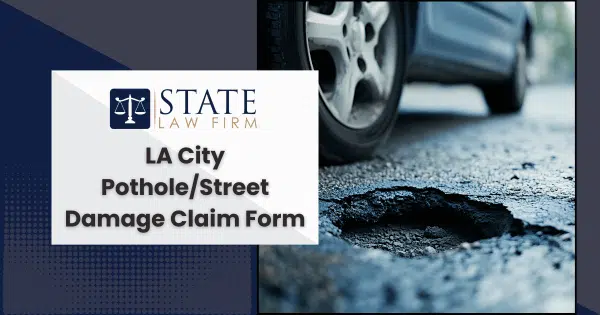If a pothole, broken sidewalk, or other street defect in Los Angeles damaged your car or caused an injury, the City provides a formal process to seek reimbursement. This guide explains what the Los Angeles “Claim for Damages” form is, who can use it, which deadlines apply, and how to complete and file it correctly the first time.
Before you decide, read our guide to Car accident lawyers to understand your rights and how claims are valued.
What the LA City Claim for Damages Form Covers
Los Angeles uses Form 100-A, “Claim for Damages to Person or Property,” for money-damage claims against the City. You use this form when you believe a City action or inaction caused your loss. Typical street and sidewalk scenarios include:
- Vehicle damage from potholes, such as blown tires, bent rims, suspension damage, or alignment issues.
- Bicycle or scooter crashes caused by uneven pavement, roadway trenches, or defective utility covers.
- Pedestrians trip and fall due to raised slabs, missing sidewalk panels, or hazardous construction zones in the City right-of-way.
- City vehicle incidents where a municipal truck, bus, or sedan strikes your car or you, or kicks up debris that causes damage.
If the hazard is on a state-maintained freeway or highway rather than a City street, the claim belongs with Caltrans, not the City of Los Angeles. If you are unsure who maintains the location, note the exact spot, and we can help you check maintenance responsibility.
Eligibility and Deadlines You Must Meet
California’s Government Claims Act sets strict presentation deadlines before you can sue a public entity:
- Six months from the date of the incident for personal injury, wrongful death, or damage to personal property, such as your car and its contents.
- One year from the incident for all other claims, such as some contract or real-property claims.
Late claims are very limited. Missing these windows can bar the claim. The form also requires mandatory content like your contact address for notices, a factual narrative, where it happened, why the City is responsible, and an itemized amount of money claimed. If you omit required information or forget to sign under penalty of perjury, the City can treat the claim as insufficient and send a notice listing what is missing. Correcting insufficiencies quickly preserves your progress and avoids rejection by operation of law.
Step-by-Step: How to Complete Form 100-A Correctly
The best way to avoid delays is to mirror the form section by section and be specific. Use these numbered steps as you fill out your Los Angeles Claim for Damages.
- Claimant information and notices
- Provide your full name, date of birth, phone, email, and mailing address.
- If you want notices sent to an attorney or insurer, check the box and list that person’s name, relationship, and contact information. The City will use this address for all communications.
- Incident narrative
- How it happened: Describe the sequence in plain language. Example: “Front passenger tire struck a pothole in the number two lane traveling eastbound on Sunset Boulevard at approximately 25 mph.”
- Date and time: Include the exact date and time.
- Where it happened: Give the closest street address or cross-streets, lane direction, and landmark measurements if available.
- Why the City is responsible: Briefly link the hazard to City ownership, control, or maintenance. Example: “Pothole existed within the City right-of-way for multiple days despite 311 reports” or “Raised sidewalk panel is part of City-maintained walkway.”
- Witnesses and involved parties
- List witness names and contact information.
- Identify any City employees involved, City vehicle license plates, and City departments or bureaus you believe are responsible.
- If you reported the hazard or incident, include service, claim, or report numbers from MyLA311, LAPD, or a department inspector.
- Damages and amounts
- Describe all injuries and property damage.
- State the total amount you claim and itemize by category: tire or rim replacement, suspension repair, tow charge, rideshare expenses, medical co-pays, physical therapy, lost wages, and other out-of-pocket costs.
- If bodily injury is claimed, note whether you will supplement with medical bills and records as they are issued.
- Insurance information
- List your auto or health insurer, claim numbers, and any amounts paid to date. This helps the City coordinate reimbursements and address subrogation.
- Accident diagram
- For roadway incidents, include a hand-drawn diagram showing street names, lane positions, traffic direction, landmarks, and the exact location of the defect marked with an “X.” If the form diagram does not fit your situation, attach your own.
- Signature
- Sign and date the form under penalty of perjury. If a representative signs, make sure the relationship to the claimant is stated.
Pro tip: Use concise, factual sentences. Attach separate, signed pages if you need more space, and label each attachment with the corresponding form section number.
Evidence and Attachments That Strengthen Your Claim
Strong documentation speeds review and increases the chance of reimbursement.
- Photos and video taken as close in time to the incident as possible, including close-ups of the defect, wide shots showing context, and damage to your vehicle, bike, or personal items.
- Repair estimates and invoices for tires, wheels, suspension, or body work. Include a technician’s note tying the damage to road impact when available.
- Tow and rental or rideshare receipts to document consequential costs.
- Medical records and bills for injuries. Include urgent care or ER records, imaging, primary care notes, and physical therapy plans.
- Witness statements with contact information.
- Maps and measurements that pinpoint the exact location in the right-of-way. Screenshots from mapping apps can help.
- 311 service numbers, police report numbers, or City work orders that show prior notice or hazard history.
File neat, legible attachments. If you file online, you can upload support now and supplement later.
How and Where to File Your Claim
You must file with the Office of the City Clerk, not with individual departments.
Three ways to file:
- Online at the City’s claims portal. You receive a claim number immediately and a confirmation email. If an upload error occurs, submit the claim first and add documents later through the portal or to the assigned investigator.
- By mail to:
Office of the City Clerk
200 North Spring Street, Room 395, City Hall
Los Angeles, CA 90012 - In person at the same City Hall address during business hours.
Important: The City states that emailed or faxed claims are not accepted. Use the online portal, mail, or in-person filing.
After You File: Tracking, Timing, and Outcomes
- Claim number and routing: Online filers get a claim number on submission. After the Clerk receives your claim, it is routed to the Los Angeles City Attorney’s Office Claims Division for investigation.
- Typical timing: By statute, the City generally has 45 days to accept, compromise, or reject a claim, unless both sides agree in writing to extend the review. If the City does not act within 45 days, the claim is deemed rejected by operation of law.
- Notices to watch for: A Notice of Insufficiency asks you to correct missing mandatory elements before action can be taken. A Notice of Rejection starts the litigation clock for most California claims.
- If rejected in writing: You typically have six months from the date of personal delivery or mailing of the rejection notice to file a lawsuit. If no proper written rejection is provided, many claims allow two years from accrual to sue. These are general rules with exceptions, so evaluate your specific timeline promptly.
For status updates after filing, you can contact the City Attorney’s Claims Division or reply to the investigator once assigned.
Common Mistakes That Delay or Sink Claims
Avoid these preventable errors that routinely trigger delays or denials:
- Missing mandatory fields such as your notice’s address, incident date and time, or total amount claimed.
- No signature under penalty of perjury.
- Vague location without cross-streets, lanes, or direction of travel.
- Not explaining the City’s responsibility for the hazard or incident.
- Submit by fax or email instead of the portal, mail, or in person.
- Forgetting the accident diagram or omitting photographs for roadway claims.
- No proof of loss, such as invoices, estimates, medical records, or receipts.
- Waiting until the deadline reduces your ability to cure an insufficiency within the 45-day window.
Need Help With Your Claim
State Law Firm helps Los Angeles drivers, cyclists, and pedestrians recover their losses after pothole and street-defect incidents. We can review your draft claim, organize your evidence pack, and protect your deadlines. If you have already received a denial, we will evaluate your next steps to preserve litigation timelines.
Next step: Send us your incident date, claim number if assigned, and any photos or estimates you have. We will do a quick review and let you know what to add before you file or how to position your case after filing.
The City’s Claim for Damages process is workable if you file on time, provide the mandatory content, and attach clear proof of loss. Use the portal or City Hall filing to get a claim number, monitor for written notices, and be ready to act within the applicable deadlines. If you want a second set of eyes, we are here to help.


